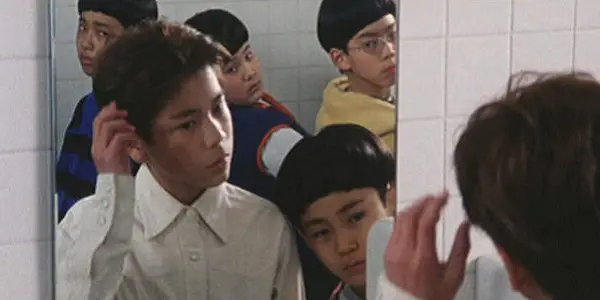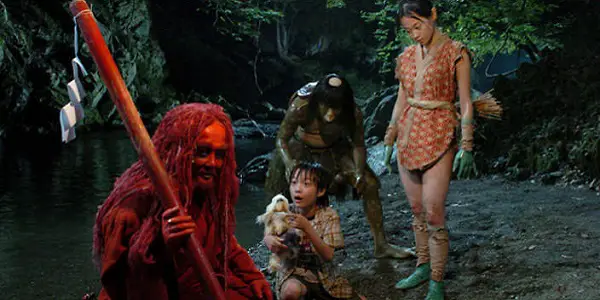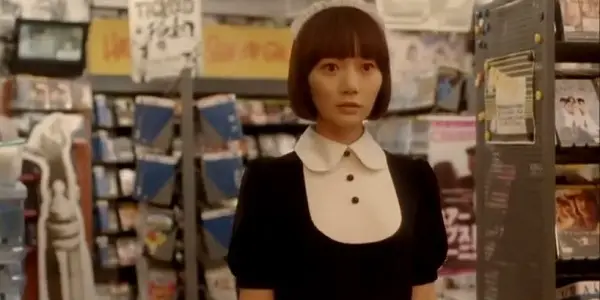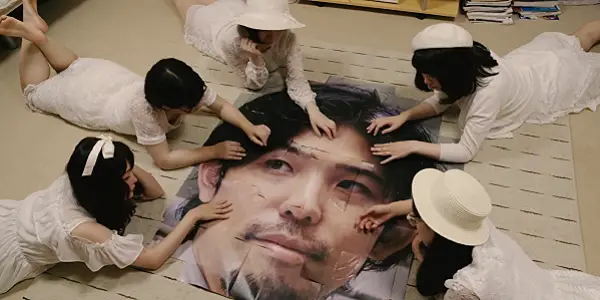21st CENTURY JAPAN: FILMS FROM 2001-2020: Highlights from the Screening Series

Lee Jutton has directed short films starring a killer toaster,…
Throughout the month of February, Japan Society and Agency of Cultural Affairs of the Government of Japan are presenting the inaugural ACA Cinema Project online film series, 21st Century Japan: Films from 2001-2020. This selection of 30 films, celebrating the past 20 years of Japanese cinema, is streaming online throughout the U.S. on the Japan Society’s virtual cinema platform. It’s a wide-ranging series, featuring lesser-known films by globally renowned directors Takashi Miike and Hirokazu Kore-eda, the work of key Japanese women directors like Naomi Kawase and Naoko Ogigami, a spotlight focused on the films of Kiyoshi Kurosawa, and the online U.S. premiere of the latest from maverick director Sion Sono. Below are a few highlights.
Yoshino’s Barber Shop (Naoko Ogigami)
Released in 2004, Naoko Ogigami’s delightful debut feature takes place in a small mountain town extremely devoted to its local traditions, one of which decrees that all school-age boys must have the same unflattering bowl haircut. The hairstyle, dubbed “the Yoshino cut” in honor of the barbershop that has administered it for generations, is supposed to protect the boys from being kidnapped by the spirit of the mountain, the idea being that if the spirit cannot tell the boys apart, he won’t know who to steal. The current (and only) barber, Mrs. Yoshino (Masako Motai) is extremely proud of her role in the community. But, that all changes when a new kid arrives in town from Tokyo and refuses to give up his trendy hairstyle in favor of the Yoshino cut.

That boy, Yosuke (Hoshi Isida), ends up befriending a group of his fifth-grade classmates, including Mrs. Yoshino’s son, Keita (Ryo Yoneda). Together, the boys pore over stolen porno mags in their secret hideout, longing to tell a female classmate how they feel. Eventually, they learn that their hairstyle is deemed quite uncool outside of their small village, and decide that they too want to abandon the Yoshino cut. However, this seemingly small act of rebellion causes an uproar in their old-fashioned town, especially with Mrs. Yoshino.
Unlike many coming-of-age stories about preteens, Ogigami’s film features enough swearing and pornography to actually feel like a realistic portrayal of kids on the cusp of growing up. Said kids are absolutely charming in their roles, especially Yoneda as the boy torn between his loyalty to his mother and his desire to break away from tradition and try something new, even if it might hurt his mother’s feelings. The film’s tone is light and spirited, as is befitting a film whose main conflict revolves around something as simple as haircuts. Yet hidden beneath the warm and fuzzy exterior is a surprisingly weighty exploration of societal conformity and the importance of individuality, especially when it comes to kids who are still in the process of becoming fully formed humans. Overall, Yoshino’s Barber Shop is a little gem that is guaranteed to bring a smile to your face (and make you crave a new haircut).
The Great Yokai War (Takashi Miike)
The extraordinarily prolific Takashi Miike boasts an oeuvre that runs the gamut of genres, though he is best known for directing hyper-violent, controversy-courting thrillers like Audition and Ichi The Killer. However, The Great Yokai War is far more similar to Yoshino’s Barber Shop than either of those films, as it too focuses on a young boy trying to find himself. Yet because this is Miike, this is no ordinary coming-of-age drama, but a bombastic action film packed with extraordinary creature design and effects.

Tadashi (Ryunosuke Kamiki) is a lonely new kid in a small town. At a local festival, he is declared that year’s Kirin Rider, a protector of all things good. Yet this is no mere affectation, as soon Tadashi finds himself facing off against an evil spirit named Yasunori Katō (Etsushi Toyokawa). Katō desires revenge on the modern Japanese people and plans to achieve this by transforming creatures from Japanese mythology known as the yōkai into massive cyborg-style creatures that will wreak havoc on society. Tadashi befriends a few yōkai, including an adorable little catlike Muppet of a creature known as a sunekosuri, and sets out to stop Katō before he destroys the world.
There is a lot to take in both visually and sonically in The Great Yokai War, and I’m sure it definitely helps to already be familiar with the various legends of the yōkai before sitting down to watch it. I was not, and as a result, it was all too easy for me to become overwhelmed by the endless cascade of supernatural creatures and their specific abilities, including the water sprite Kawahime (Mai Takahashi) and the amphibious imp Kawataro (Sadao Abe). That being said, the creature design is awesome, mostly because in many instances it is charmingly lo-fi, with rubber masks and practical makeup taking the place of the CGI that we’ve become used to as of late. Miike’s signature dark humor and taste for chaos are on full display here, even if the film itself is far less disturbing than adult Miike fans would generally expect. Released in 2005, a sequel is set for release later this year, so if you’re a fan of monster movies and mythology, there’s no better time to watch it.
Sakuran (Mina Ninagawa)
Based on the manga series of the same name, Sakuran chronicles the life of a girl who is sold into service at a brothel as a young child and rises through the ranks to become its most popular and powerful courtesan. Released in 2006, the film marked the directorial debut of photographer Mika Ninagawa, known for her bright and colorful work focused on flowers and other aspects of the natural world. That well-honed sense of visual whimsy is on full display in Sakuran, which does for 18th century Japan what Sofia Coppola’s Marie Antoinette did for that doomed queen’s reign: render it a candy-colored fantasy with some fun modern twists.

As the spirited, rebellious Kiyoha (a phenomenal Anna Tsuchiya) grows up, she evolves from being the handmaid of the brothel’s top courtesan to being her rival. Despite several failed attempts to run away—including once to join a man that she thought she loved—Kiyoha always ends up coming back to the only home she has ever really known. There, she befriends a young man who lives and works in the brothel (his mother was also a courtesan); his kindness is one of the only constants in her chaotic life. Fortunately, in addition to her exotic beauty (Tsuchiya is Japanese, Irish, and Polish) and snarky wit, Kiyoha also has an inner fire that no amount of heartbreak and drama can entirely put out. Whether she’s starting a fistfight with another girl while waiting to be chosen by a customer or turning a rich man down flat for daring to try and buy her affections, it’s easy to root for someone as bold and beautiful as Kiyoha.
Many sequences in the film, such as Kiyoha’s first promenade down the streets to look for high-class customers, feel more like music videos than scenes from a narrative feature, thanks to Ninagawa’s visually stunning direction and Ringo Sheena’s rollicking, genre-busting soundtrack. Namiko Iwaki’s production design is some of the most gloriously eye-catching I have ever seen, featuring high-contrast reds and blues, and the colorful costumes add a stylish and contemporary twist (we’re talking shiny pinks paired with animal prints) to one’s idea of traditional Japanese fashion. At the center of it all is Tsuchiya, whose twinkling eyes and stubborn smirk bring Kiyoha to vibrant life. While I don’t know if model/singer/actor Tsuchiya’s notoriously wild offscreen life contributed to Ninagawa’s casting of her, it definitely shines through in her performance. Even as the film dangerously wobbles on the tracks of its rollercoaster of a plot, Tsuchiya’s striking screen presence and Ninagawa’s directorial flair manage to keep you fully engaged with Sakuran.
Air Doll (Hirokazu Kore-eda)
Hirokazu Kore-eda’s brilliant Shoplifters, chronicling the lives of a chosen family of misfits that rely on shoplifting to survive, won the Palme d’Or at the Cannes Film Festival before being nominated for an Academy Award for Best International Film in 2019. But nearly a decade prior, Kore-eda directed a film so heartbreaking that it makes Shoplifters look like a fluffy screwball comedy. Starring Bae Doona in a beautifully subdued performance as Nozomi, an inflatable sex doll who comes to life, Air Doll examines the loneliness that is endemic in modern urban life, and the struggle to find human connection amidst it all.

Nozomi is the beloved companion of a middle-aged man, Hideo (Itsuji Itao), who dresses her in extravagant outfits, has meals with her sitting at his kitchen table, and yes, has sexual intercourse with her. But one day, Nozomi comes to life. Leaving the apartment while Hideo is at work, she spends her days exploring the city, observing human life, and working at a local video store. There, she falls in love with a coworker, Junichi (Arata), who seems to reciprocate her feelings despite being fully aware she is an inflatable doll, even helping mend and re-inflate her when she gets a tear at work. But no matter how hard she tries, from applying makeup to cover the seams in her plastic skin to visiting her maker to understand how she came to be, it’s clear that Nozomi cannot have a normal human life.
Like Sakuran, Air Doll is also adapted from a manga, but it’s hard to think of a more tonally different film. If Sakuran is the cinematic equivalent of a riot grrrl punk song, Air Doll is a delicate and sensitive ballad, sparse in composition but no less emotionally impactful for it. Doona combines the halting physicality of a doll just learning how to move its limbs with an open, inquisitive expression that cries out for a friend; she walks the line of acting subtly “doll-like” without flying off the edge into hokiness. Even the quietest of scenes, such as an encounter with a pile of dolls like herself that have been discarded, feel like a punch to the solar plexus courtesy of her performance.
While the premise may sound goofy or lurid, Kore-eda’s Air Doll is one of the most touching films I’ve seen in recent memory. All Nozomi wants is to feel a connection with someone, and be loved by them; the irony is that men like Hideo want dolls like her because they don’t want to deliver on their end of the bargain. When Hideo discovers that Nozomi is now real, he chooses to replace her with another doll instead of carrying on a human relationship with her. After all, it’s easier to bare your soul to an inanimate object than someone with a soul.
Fires on the Plain (Shinya Tsukamoto)
Adapted from the acclaimed novel by Shohei Ooka, Fires on the Plain is a harrowing depiction of one Japanese soldier’s desperate attempts to survive in the Philippines jungle in the waning days of World War II. It was previously adapted in 1959 by Kon Ichikawa; the resulting film was controversial for its bleak depictions of war violence and cannibalism. This version, released in 2014, has multihyphenate Shinya Tsukamoto at the helm…and as writer, producer, co-cinematographer, production designer, editor, and star. It’s a heavy load to carry on what is already an incredibly heavy film about human degradation and the depths to which one is willing to sink in order to survive.

Tamura (Tsukamoto) is suffering from tuberculosis; his already diminished company has no use for a sick man, but the military hospital won’t take him either, preferring to focus on soldiers with life-threatening injuries. So, with no other options, Tamura begins wandering aimlessly through the jungle in search of a way out. Along the way, he encounters fellow soldiers who are retreating; an ambush by American soldiers results in flying limbs, fountains of blood, and few survivors. When Tamura encounters another delirious, dying soldier, the man tells Tamura he can eat him when he dies. Tamura is disgusted and flees, yet the specter of cannibalism looms over the jungle, where each soldier barely has enough yams to gnaw on to survive.
With its unusual editing techniques, including some startling fades to white, Fires on the Plain occasionally feels like a fever dream; indeed, who knows how much of what Tamura is seeing is the imaginings of his delirious mind. Yet the film’s visceral depictions of the ravages of war—particularly when one is on the losing side and knows it—also feel all too hauntingly real. That Tsukamoto was able to take on such an intense acting role while also filling so many roles in production is a remarkable achievement; his Tamura is essentially our Virgil, guiding us through the hell that is an army’s last, desperate gasps. Tamura’s struggle to not cross what is presented as the ultimate line—consuming his fellow man in order to survive—is a big part of what keeps us on his side, rooting for him to eventually make it out. Yet as the film shows us, some nightmares never truly leave us; for all too many soldiers, war is one of them.
Red Post on Escher Street (Sion Sono)
One of the most idiosyncratic filmmakers working in global cinema, let alone Japan, Sion Sono turns his unique viewpoint back on the Japanese film industry in his latest, Red Post on Escher Street. The film is focused on young, hot-shot director Tadashi Kobayashi (Tatsuhiro Yamaoka), who has been recruited to bring his festival cred to a big studio picture. Kobayashi has one condition: if he’s going to take on this film, he’s going to bring some of his own style to the production and use a cast of amateurs, not glossy professionals.

Flyers for an open casting call begin to litter the streets, and an eccentric cast of characters prepare to audition. They include the members of a small all-woman acting troupe, two of whom are romantically entangled with Kobayashi’s assistant; a young widow named Kiriko (a lovely Matsuri Kohira) who hopes to fulfill her deceased husband’s dreams of becoming an actor by becoming one herself; and Yasuke (the charismatic Sen Fujimaru) a possibly unhinged young woman whose father recently stabbed himself to death in their home. One cannot leave out the members of the Tadashi Kobayashi True Love Club, a group of white-clad women who are so devoted to the director that they gather around a poster-sized image of his face to pay homage to his talents.
The whole time, Kobayashi is haunted by the memory of another young woman he cast a long time ago and who became a beloved collaborator, Katako (Mala Morgan). He makes his choices, only to be told by the studio that he is required to cast a trio of female stars, including one up-and-comer whose talents just don’t meet Kobayashi’s lofty standards. The rejected auditioners turn up on set to work as extras, and the resulting film shoot is one of the wildest to be depicted on screen since Rainer Werner Fassbinder’s Beware of a Holy Whore, a borderline-hallucinatory riot of emotion. (It’s no surprise that Sono cites the equally eccentric Fassbinder as one of the influences on his work.) A love letter to the faces in the background of every film, Red Post on Escher Street argues that everyone can and should seize the chance to be a star, even if it is just in the story of one’s own life. Many of the actors in the film are amateurs themselves, bringing the film’s philosophy full circle. It is riotously funny, occasionally disturbing, and always fascinating—the epitome of Sion Sono.
Conclusion
This is obviously is only a small selection of what is being screened in this series, which itself is only a small selection of the brilliant Japanese cinema that has been produced over the past two decades. But no matter what your taste in movies is, you’re guaranteed to find something you’ll enjoy here. To paraphrase the great South Korean filmmaker Bong Joon-ho, if you’re not frightened off by subtitles, you’ll be rewarded richly with so many wonderful films. And thanks to Japan Society and Agency of Cultural Affairs, right now they’re more accessible than ever.
What do you think? Which films sound the most appealing to you? Share your thoughts in the comments below.
21st Century Japan: Films from 2001-2020 streams online throughout the U.S. on the Japan Society’s virtual cinema through February 25, 2021.
Does content like this matter to you?
Become a Member and support film journalism. Unlock access to all of Film Inquiry`s great articles. Join a community of like-minded readers who are passionate about cinema - get access to our private members Network, give back to independent filmmakers, and more.
Lee Jutton has directed short films starring a killer toaster, a killer Christmas tree, and a not-killer leopard. Her writing has appeared in publications such as Film School Rejects, Bitch: A Feminist Response to Pop Culture, Bitch Flicks, TV Fanatic, and Just Press Play. When not watching, making, or writing about films, she can usually be found on Twitter obsessing over soccer, BTS, and her cat.













